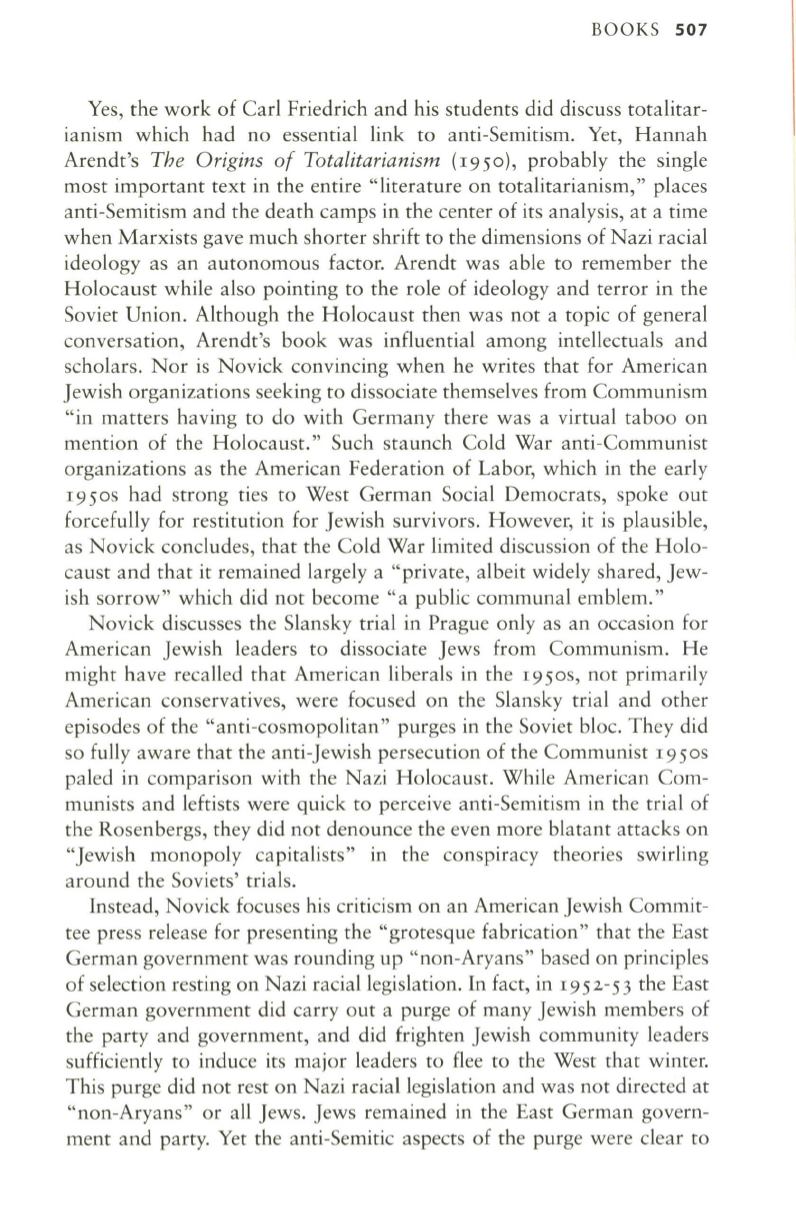
BOOKS
507
Yes, the work of Carl Friedrich and his students did discuss totalitar–
ianism which had no essential link to anti-Semitism. Yet, Hannah
Arendt's
The Origins of Totalitarianism
(1950),
probably the single
most important text in the entire "literature on totalitarianism," places
anti-Semitism and the death camps in the center of its analysis, at a time
when Marxists gave much shorter shrift to the dimensions of Nazi racial
ideology as an autonomous factor. Arendt was able to remember the
Holocaust while also pointing
to
the role of ideology and terror in the
Soviet Union. Although the Holocaust then was not a topic of general
conversation, Arendt's book was influential among intellectuals and
scholars. Nor is Novick convincing when he writes that for American
Jewish organizations seeking
to
dissociate themselves from Communism
"in matters having
to
do with Germany there was a virtual taboo on
mention of the Holocaust." Such staunch Cold War anti-Communist
organizations as the American Federation of Labor, which in the early
1950S
had strong ties to West German Social Democrats, spoke out
forcefully for restitution for Jewish survivors. However, it is plausible,
as Novick concludes, that the Cold War limited discussion of the Holo–
caust and that it remained largely a "private, albeit widely shared, Jew–
ish sorrow" which did not become "a public communal emblem."
Novick discusses the Slansky trial in Prague only as an occasion for
American Jewish leaders to dissociate Jews from Communism. He
might have recalled that American liberals in the
1950S,
not primarily
American conservatives, were focused on the Slansky trial and other
episodes of the "anti-cosmopolitan" purges in the Soviet bloc. They did
so fully aware that the anti-Jewish persecution of the Communist
1950S
paled in comparison with the Nazi Holocaust. While American Com–
munists and leftists were quick
to
perceive anti-Semitism in the trial of
the Rosenbergs, they did not denounce the even more blatant attacks on
"Jewish monopoly capitalists" in the conspiracy theories swirling
around the Soviets' trials.
Instead, Novick focuses his criticism on an American Jewish Commit–
tee press release for presenting the "grotesque fabrication" that the East
German government was rounding up "non-Aryans" based on principles
of selection resting on Nazi racial legislation.
In
fact, in
1952-
53 the East
German government did carry out a purge of many Jewish members of
the party and government, and did frighten Jewish community leaders
sufficiently
to
induce its major leaders to flee to the West that winter.
This purge did not rest on Nazi racial legislation and was not directed at
"non-Aryans" or all Jews. Jews remained in the East German govern–
ment and party. Yet the anti-Semitic aspects of the purge were clear
to


